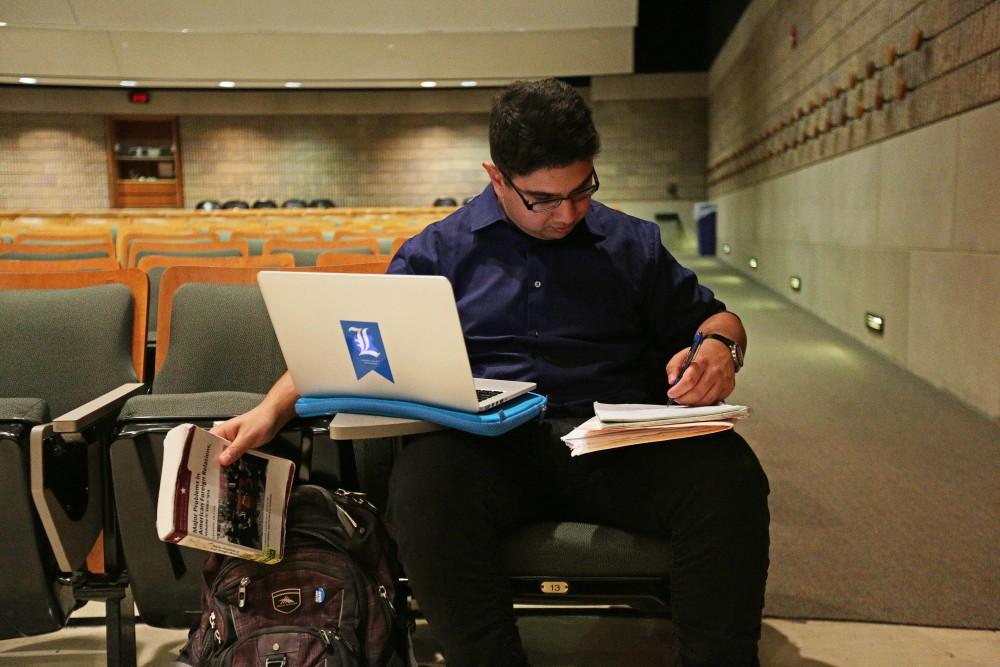Survey finds tablet desks hinder learning

GVL / Emily Frye Arpan Lobo in Loutit Lecture Hall on Wednesday November 15, 2017.
Nov 16, 2017
Students’ comfort in the classroom can often be overlooked. Nevertheless, how well students are able to focus on what a professor is saying, rather than how they are sitting, can make or break a grade. According to a recent survey conducted at Grand Valley State University, tablet chairs found in certain classrooms are negatively impacting learning for some students.
The survey was conducted by Doug Graham, GVSU professor of biomedical sciences. Graham conducted the survey for the Faculty Facilities Planning Advisory Committee (FFPAC), which examines the spaces where faculty and students interact. It found that 73 percent of students surveyed found the tablet chairs to be either a slight or significant inconvenience.
The chairs get their name from the small desk size, which is large enough to fit a tablet, rather than a laptop.
The survey was distributed to a sample size of approximately 3,000 students who are enrolled in one class that meets in a room with tablet chairs. The response rate was 18 percent, meaning 550 students took the survey. The results did not come as a shock to Graham, however, who teaches in classrooms with the chairs.
“In a lot of ways, this wasn’t surprising,” he said. “People hate these chairs. Lefties don’t always—if ever—have access.”
Those surveyed had the opportunity to leave comments afterward. Responses included “these chairs are trash” and “I hate these chairs,” and one student even wrote that they considered bringing their own chair to classes because they were too tall to fit in the desks.
As Graham suggested, the chairs can be especially difficult to work with for students who write left-handed. The survey asked 31 lefties if left-handed desks were always available in classrooms, and only six percent found that the desks were available in sufficient numbers for students to be able to get them.
Megyn Beebe, a GVSU student who writes left-handed, often has trouble finding a left-handed desk.
“I can never find one,” she said. “Sometimes I’ll even have to write on the desk to my left if no one’s next to me.” Beebe also described her difficulties as being detrimental to her learning.
Left-handed students also revealed how using right-handed tablet desks impacted them. By moving a slider, students could rate from one to 100, with one being “I don’t really notice it. It’s not an issue” to 100 being “It’s a significant ergonomic hindrance that impacts my learning.”
The difficulties students have with the chairs aren’t just limited to handedness. In the survey, students left comments stating that the desks affected their concentration, handwriting ability and overall learning experience.
One student wrote that it was “nearly impossible to stay focused on the content of the class when I am spending almost the entire class trying to find a way to sit comfortably so I can take effective notes.”
The rationale behind having the desks, according to Graham, is being able to fit more into a classroom. For example, one room in Lake Superior Hall, Room 225, had 31 of the tablet desks, as well as three other full-sized desks. Thirty-four desks could hold a class well above the GVSU average of 26. While sampling just one classroom is inadequate, it does illustrate the ability to place a greater number of desks in a room.
According to Graham, GVSU Facilities Planning is ordering more left-handed versions of the desks for next semester to accommodate students. This is a welcomed change for students like Beebe.
“It’s good,” she said. “It’s just hard to take notes in class without a left-handed desk.”
In the meantime, students will have to remain focused despite the difficulties that come with the chairs.





















